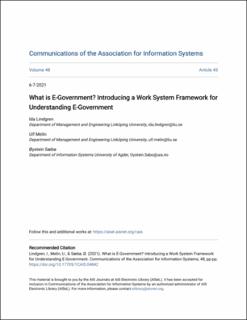| dc.contributor.author | Lindgren, Ida | |
| dc.contributor.author | Melin, Ulf | |
| dc.contributor.author | Sæbø, Øystein | |
| dc.date.accessioned | 2023-09-21T12:13:32Z | |
| dc.date.available | 2023-09-21T12:13:32Z | |
| dc.date.created | 2021-02-10T10:34:27Z | |
| dc.date.issued | 2021 | |
| dc.identifier.citation | Lindgren, I., Melin, U. & Sæbø, Ø. (2021). What is e-Government? Introducing a Work System Framework for understanding e-Government. Communications of the Association for Information Systems, 48, 503-522. | en_US |
| dc.identifier.issn | 1529-3181 | |
| dc.identifier.uri | https://hdl.handle.net/11250/3091084 | |
| dc.description | Copyright 2021, by the Association for Information Systems. Permission to make digital or hard copies of all or part of this work for personal or classroom use is granted without fee provided that copies are not made or distributed for profit or commercial advantage and that copies bear this notice and full citation on the first page. Copyright for components of this work owned by others than the Association for Information Systems must be honored. Abstracting with credit is permitted. To copy otherwise, to republish, to post on servers for commercial use, or to redistribute to lists requires prior specific permission and/or fee. Request permission to publish from: AIS Administrative Office, P.O. Box 2712 Atlanta, GA, 30301-2712, Attn: Reprints, or via e-mail from: publications@aisnet.org. | |
| dc.description.abstract | In this paper, we present a comprehensive and distilled model that can help researchers to 1) enter the e-government field, 2) understand what the field mainly studies in a distilled way, and 3) reflect on further research in the field. Departing from Steven Alter’s (2013) work systems theory and particularly his work systems framework (WSF), we introduce a framework for understanding e-government work systems (i.e., the eGovWSF). We distil the basic core of e-government work systems through an interpretative and hermeneutic approach by building on previous research and theorizations made in information systems and e-government research. We unpack the eGovWSF into 12 main elements; discuss their role as internal, semi-external, and external to e-government work systems; and reflect on the connections between these elements. Thus, contributions include a conceptual discussion on e-government’s core subject matter, the framework’s applicability, and future research needs. | en_US |
| dc.language.iso | eng | en_US |
| dc.publisher | Association for Information Systems (AIS) | en_US |
| dc.rights | Attribution-NonCommercial-NoDerivatives 4.0 Internasjonal | * |
| dc.rights.uri | http://creativecommons.org/licenses/by-nc-nd/4.0/deed.no | * |
| dc.title | What is e-Government? Introducing a Work System Framework for understanding e-Government | en_US |
| dc.type | Peer reviewed | en_US |
| dc.type | Journal article | en_US |
| dc.description.version | publishedVersion | en_US |
| dc.rights.holder | © 2021 the Association for Information Systems | en_US |
| dc.subject.nsi | VDP::Samfunnsvitenskap: 200::Biblioteks- og informasjonsvitenskap: 320 | en_US |
| dc.subject.nsi | VDP::Matematikk og Naturvitenskap: 400::Informasjons- og kommunikasjonsvitenskap: 420 | en_US |
| dc.subject.nsi | VDP::Teknologi: 500::Informasjons- og kommunikasjonsteknologi: 550 | en_US |
| dc.source.pagenumber | 503-522 | en_US |
| dc.source.volume | 48 | en_US |
| dc.source.journal | Communications of the Association for Information Systems | en_US |
| dc.identifier.doi | https://doi.org/10.17705/1CAIS.04842 | |
| dc.identifier.cristin | 1888387 | |
| dc.description.localcode | Paid open access | en_US |
| dc.source.articlenumber | 42 | en_US |
| cristin.qualitycode | 1 | |

